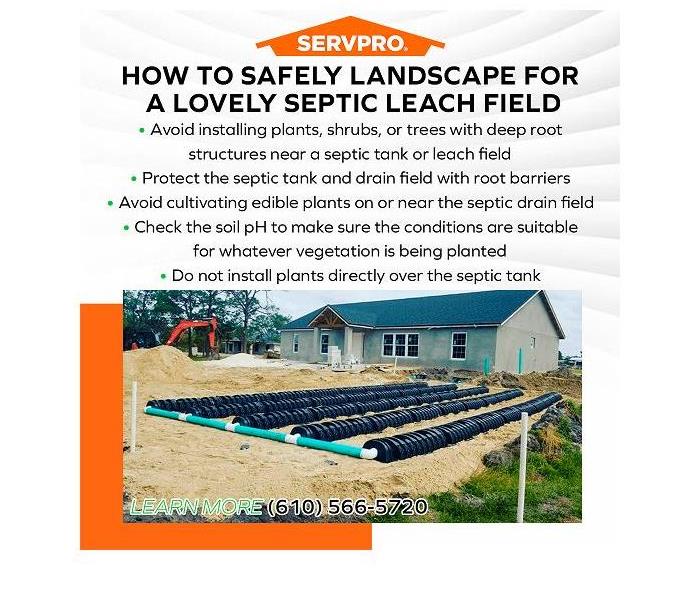The Do’s and Don’ts of Landscaping over the Septic Tank to Prevent Septic-Related Flood Damage
3/13/2023 (Permalink)
Blog Summary: SERVPRO of Media offers advice on beautifying and benefiting the septic drain field without causing septic-related flood damage.
SERVPRO® of Media provides flood restoration services for clients in Media, PA, and the surrounding area. When the cause of the flooding is a sewage backup, professional cleaning and restoration services are essential for a thorough restoration project that leaves the flooded areas of the home clean, sanitary, and safe.
The leach field for Newtown Square, PA, homes with a septic tank needs to be carefully managed to prevent any interference with the septic system. With the correct landscaping, this section of the yard can present a strong aesthetic appeal while boosting the efficiency and safety of the septic system hidden beneath the soil.
Below are some septic-friendly plants and landscaping principles that help homeowners create a safe, beautiful lawn over the septic leach field.
What to look for in septic-safe plants
Landscaping over the septic system brings benefits and risks. A nominal approach of gravel or plain soil exposes the location to storm runoff and erosion. A cover of wisely chosen vegetation prevents erosion and absorbs excess water, which reduces the risk of flooding. Vegetation cannot correct substantial grading issues. A certified landscape architect can advise on resolving drainage issues and flooding on or near the drain field.
The top priority of any planting plan involving a septic drain field is dealing with roots and root structures. A deep, thick mat of roots in and around the septic tank and drain field can lead to clogged or broken pipes, a ruptured tank, a sewage spill around the tank, or a sewage backup in the home. Toilets, tubs, and showers may ooze raw, smelly, unsanitary sewage. If the pressure within the system is not released, sewage drain pipes in the basement or crawl space can crack or separate, leading to a massive sewage spill.
Drought-tolerant plants do not require irrigation. Too much water on top of the septic system slows the evaporation rate. Evaporation is essential to the function of the system. Alkaline cleaners that get into the system elevate salt levels in the soil around the system, creating unfavorable conditions for plants that are sensitive to high salt levels in the soil. If the pH levels do not benefit the plants, the homeowner wastes time and money.
Soft, woody, shallow-rooted grass and weeds benefit the drain field by stabilizing the moisture content in the soil. When it comes time to dig up the septic tank lid or access pipes buried in the ground, tender plants make digging and excavating easier. Shallow-rooted, herbaceous, flowering annuals and perennials bring depth and color to the drain field. The local lawn and garden store or agricultural extension agent can provide advice on what to plant.
How shrubs and trees can cause a sewage backup
Most trees and shrubs have extensive root systems, and the tough, woody roots and stems are not septic-safe. Trees and shrubs growing near the septic system should be professionally removed to prevent damage. Failure to deal with these plants can damage the system and eventually cause sewage backups. For the sake of the septic system, avoid planting any trees or shrubs in the vicinity of the septic system.
How to safely landscape for a lovely septic leach field
- Avoid installing plants, shrubs, or trees with deep root structures near a septic tank or leach field.
- Protect the septic tank and drain field with root barriers. Thick landscape fabric or wooden planks that impede the growth of roots and shield the septic system will work. The barriers should extend to a depth of at least two feet and should be five feet or more from the leach field.
- Avoid cultivating edible plants, such as vegetables, berry bushes, or culinary herbs, on or near the septic drain field. Contaminants from the system could be trapped in the surrounding soil. These contaminants are taken up by the roots of nearby vegetation, including plants in a vegetable or herb garden. Any cultivated or wild plant growing on or near the septic system should be considered unfit for human consumption. Also, wear protective gloves when handling plants and grass clippings from the drain field. Flowers growing in or near the drain field should not be picked and displayed in the home.
- Check the soil pH to ensure the conditions are suitable for whatever vegetation is planted over the drain field.
- Do not install plants directly over the septic tank. Every several years, the lid may need to be excavated and removed to pump out the tank. The additional weight of raised beds on the septic tank area could possibly damage the tank. The additional bedding soil can adversely impact the evaporation rate of the drain field, and the decrease in efficiency may result in more frequent pumping.
A sewage backup requires immediate professional attention. Cleanup and restoration can be messy. The IICRC-certified professionals at SERVPRO of Media have the training, experience, and equipment for a quick, safe, and sanitary cleanup and restoration. Available 24/7, 365 days a year, including holidays, the flood damage cleanup crew can be on the scene in about an hour.
To learn more about flood damage restoration, contact SERVPRO of Media by phone at (610) 566-5720 or by email at office@SERVPROmedia.com.





 24/7 Emergency Service
24/7 Emergency Service
